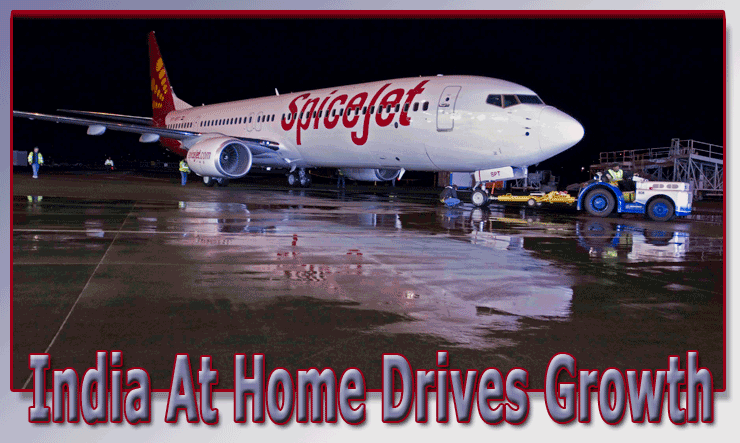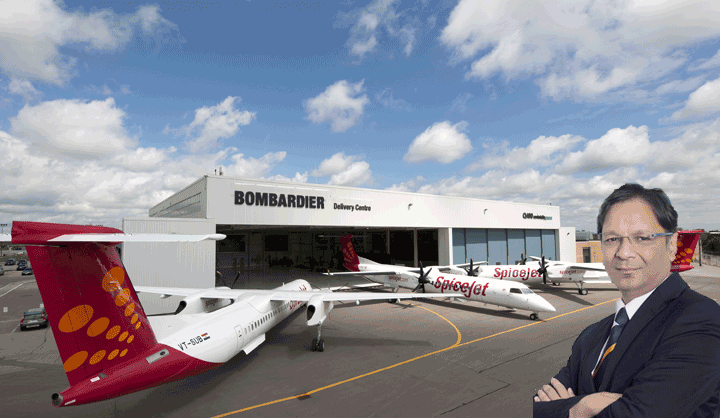
Blame India’s
tech-savvy Prime Minister for the e-tail boom, but Narendra
Modi’s push for smart cities and his love for social
media have encouraged mouse-chasing Indians to go clickety-click
from the confines of their homes.
The result? Domestic cargo
has been experiencing growth and even low-cost carriers,
with their constraints of quick turnaround times at airports,
are going all out to get express cargo packages.
Double
Digit Growth
Figures from the Directorate
General of Civil Aviation point out that the country’s
domestic cargo has seen a whopping double-digit growth in
the last 16 months – though the highest figures have
been recorded at the metro airports of Delhi, Mumbai, Bengaluru,
and Hyderabad.
The latest to start serious
air cargo services in the country is low-cost carrier SpiceJet.
After going through a near-death scenario at the end of
last year when the carrier saw its initial promoter, Ajay
Singh, (in photo below) coming back to take over the reins
and revive the company, SpiceJet is keen to embrace cargo
to boost its revenues.

Losing
Its Shirt
Incidentally, SpiceJet has
huge accumulated losses of $477 million as of June 30, 2015,
against shareholders funds (including advances towards subscription
securities) of just $182 million.
Today, the company’s
total liabilities exceed its total assets by $17.50 million.
Also, according to the Centre for Asia Pacific Aviation
(CAPA), the carrier needed “critical” investment
of $200 million for a turnaround.
Hence, all the more reason
to look for a source of revenue.
SpiceJet sources pointed out
that in August 2015, the carrier earned a little over a
million U.S. dollars from cargo and though figures were
yet to come in at the point of filing this report, September
would see the earnings shoot up to $4.5 million in October,
which is in the midst of the festive season in the country.
For the moment, revenues from
cargo operations total 3-4 percent of the airline’s
passenger revenue.
Singh said that if the air cargo services take off, the
revenues would go up to 10 percent of the passenger revenue
by the end of the current fiscal year.
Lots
of Ideas
SpiceJet Chief Operating Officer
Sanjiv Kapoor was quoted saying that the cargo operation
move was still in a planning stage and that “a lot
of ideas are being considered.”
Meanwhile, the carrier has
been working to boost its back-office: it has organized
a team that will be solely responsible for cargo.
On the other hand, it has
subscribed to SmartKargo, the cloud-based cargo IT solution,
and has also started consultations with cargo agents to
improve its services, including delivery.
The carrier has also constituted
a ‘crack team’ under Singh to oversee its cargo
operations and target customers and e-commerce companies.
In fact, SpiceJet with its
dedicated cargo plan seems to have stolen a march over the
country’s successful no-frills airline IndiGo, with
its plans to launch dedicated freighter services.
If the services materialize
in the next three to six months, SpiceJet will become the
second carrier with dedicated freighters—the other
one being Blue Dart with its seven planes—in the country.
Here
Is The Plan
The SpiceJet plan includes
starting freighter services to the country’s northeastern
region, which still remains largely unconnected.
The carrier will use aircraft
from its fourteen-strong Bombardier Q-400 fleet.
It also has eighteen B737s
and two A319s.
These planes, which are idle
at night, will be used to fly freight between Bangalore
and Delhi, according to Manjiv Singh, who is responsible
for SpiceJet’s cargo operations. “The aircraft
would be those sitting dead at night,” said Singh.
SpiceJet’s foray in
cargo comes at a crucial juncture.
Domestic cargo operators have
been aware of the coming boom and have been demanding a
boost in infrastructure.
Caution
Flag Flying
 Bharat
Thakkar, former president of the Air Cargo Agents Association
of India (ACAAI) cautioned that while domestic cargo had
gone up 18 percent last year and it is expected to grow
20 percent each month until January 2016, there was an abundance
of bellyhold cargo capacity. Bharat
Thakkar, former president of the Air Cargo Agents Association
of India (ACAAI) cautioned that while domestic cargo had
gone up 18 percent last year and it is expected to grow
20 percent each month until January 2016, there was an abundance
of bellyhold cargo capacity.
“Airlines,” he
said, “are finding it difficult to fill up the space.”
Anyone desirous of launching
freight service will have to keep these factors in mind
before making investments, he said.
According to a veteran in
the air cargo trade, Tushar Jani, chairman, Cargo Service
Centre, one of the main cargo terminals at Delhi Airport
(incidentally, he was one of the founders of Blue Dart):
“The time has come to innovate and think out of the
box. The (air cargo) industry has to move beyond the coming
year and ‘take a look at 2022.’ Air cargo,”
he underlined, “would grow without a doubt –
despite the infrastructural and other challenges.”
Today, Jani noted, integrators
were preparing for the impending boom and they would be
competitive.
In such a situation, Jani advised the domestic air cargo
industry to move out of the airport and go to the doors
of the customers and, of course, change processes.
 Manglani Delhivery Manglani Delhivery
Another major player, Bhavesh
Manglani, founder and CEO, Delhivery.com, has been in the
thick of the e-commerce boom. His outfit serviced 2 cities,
6 clients, 20 sellers, and 500 products per day in 2011
and ramped up to provide services to 175 cities, 800 clients
and 90,000 products per day in 2014.
In 2015, ‘Delhivery,’
he said, would handle around 200,000 consignments per day
and deliver to 300+ cities.
By 2020, Manglani’s
services would reach 20,000 pincodes (zip codes) or 98 percent
of the country.
Higher and higher.
Tirthankar Ghosh
|



